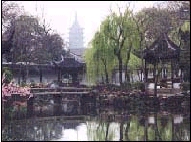 Suzhou situated in the southeast of Jiangsu Province, occupied an area of 119.2 square kilometers with a population of 880,000, between latitude 31?’ north and longitude 120?’ east. The climate is mild with an annual rainfall of 1100 mm, an average annual temperature of 15.7°C, the frost-free period of 230 days and the sunshine time is 2000 hours. Suzhou situated in the southeast of Jiangsu Province, occupied an area of 119.2 square kilometers with a population of 880,000, between latitude 31?’ north and longitude 120?’ east. The climate is mild with an annual rainfall of 1100 mm, an average annual temperature of 15.7°C, the frost-free period of 230 days and the sunshine time is 2000 hours.
Suzhou boasts favorable location, mild climate, convenient traffic, and a large number of classical gardens. It has been a famous historical and cultural city in China, an ideal place where many officials and scholars in times past purchased and planned their garden-residences as retreats for their retirement years.
Suzhou was mentioned in 484 B.C. since it was, for a few years, the capital of the State of Wu during the Period of the Warring States Period (403-221 B.C.). It flourished as a trading and silk center in the early sixth century, linked with the capital through the Grand Canal.
Encircled by the Grand Canal, Suzhou has its unique scenery of crisscrossing waterways and streets lined with houses and stone bridges. It was called a "Paradise on Earth" in ancient times and is known as the "Venice of the East" today.
During the Ming and Qing Dynasties, Suzhou saw a period of feudal economic prosperity and cultural flowering. Consequently, the number of privately-owned gardens in the city of Suzhou and its environs increased a great deal, mounting to 280 odd. A galaxy of great masters emerged and the art of landscape gardening reached its apogee. Many have survived to the present day and are open to the public such as the Blue Wave Pavilion and the Garden of the Master of the Nets first built in the Song Dynasty, the Lion Grove in the Yuan Dynasty, the Humble Administrator’s Garden and the Garden of Cultivation in the Ming Dynasty, the Garden for Lingering In, the Coupling Garden, the Garden of Harmony, the Zigzag Garden and the Listening to Maple Garden in the Qing Dynasty. The Humble Administrator’s Garden and the Garden for Lingering In, noted for their artistic perfection and individual characteristics, are known as China’s four most famous gardens along with the Summer Palace in Beijing and the Imperial Mountain Resort in Chengde. A Suzhou garden is the "origination of urban scenery", a microcosm of the world made of the basic elements of water, rocks, plants and buildings, which are arranged in such a way that they reflect the sequential beauty in the garden, the passage of time, the dissimilarity between mornings and evenings, and the succession of the seasons within the boundary of the wall and lead a sequestered life amongst the bustling city.
Ancient Chinese garden builders were all highly educated and good at verse and painting. Rich in literary allusions and analogous with the freehand brushwork in traditional Chinese painting, the classical gardens of Suzhou are the re-creation of nature through the processes of the decoration of land by planting trees, shrubs and flowers, and designing and materializing mountains and watercourses. Sometimes they are called "a silent poem and the three-dimensional painting". Strolling through a garden is like appreciating the poetic works of great master or unrolling a long scroll of Chinese landscape painting. Distinctively, garden buildings and beauty-spots have plateaus, inscribed stele are of great antiquity and parallel couplets in excellent calligraphy and tonal arrangement with the purpose of expressing owner’s temperament, moral worth, deep feeling or noble thought. There are many instances in illustration of Chinese ethical, ideological and intellectual pursuits. The Hall of Drifting Fragrance in the Humble Administrator’s Garden indicates that the owner wants to be as pure and clean as lotus blooms, and the Fragrant Isle, named after fragrant herbs, is emblematic of noble sentiments. Like an ancient hermit boat sailing about freely and happily, the Fancy Boat Study in Garden of Harmony is symbolic of the freedom of the will. The True Meaning in the Garden of the Master of Nets and the Small Utopia in the Garden for Lingering In are suggestive of the rustic simplicity of country life. Interwoven with these ideas, every rock, every waterway, every plant, and every part of the garden affords much food for thought. Indeed, the classical gardens of Suzhou are the places where people can cultivate their minds and take great pleasure in studying Chinese aesthetics. Employing extraordinary methods and techniques in older days, the garden builder successfully created within limits endless varieties of perspectives, dazzling the eye as well as the mind. The garden is full of surprises. The view is changing at every step. On a garden walk, there are countless different incidents-garden courts in succession, small bridges, murmuring brooks, white-washed walls, gray roof-tiles, numerous latticed windows with intricate patterns, pathways winding up and down hills, and leading to places of quietude, mosaics and pavements with all kinds of delicate geometric or representations of brocade, mini-gardens in out-of-the-way places, etc. It is impossible to explore and learn about them all. "With mountain chains and rivers ahead, you might think that there’s no way through. Why, shady willows and brilliant flowers keep one more village out of sight". In a word, there’s an enchanting impression of infinitude.
Other scenic spots in Suzhou include the West Garden Temple, Garden of Harmony, North Temple Pagoda and the Temple of Mystery, all well -known in China.
|